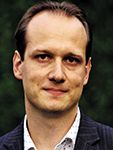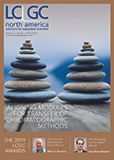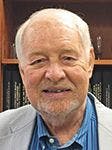The 2019 Emerging Leader in Chromatography Award: Ken Broeckhoven on Investigating the Performance Limits of HPLC Separations
LCGC North America
Ken Broeckhoven explains his pursuit of ever higher performance in HPLC.
Ken Broeckhoven, an associate professor at the Vrije Universiteit Brussel (VUB) in Belgium, is the 2019 winner of the LCGC Emerging Leader in Chromatography Award. In this interview, he discusses his work to expand the applicability of the kinetic plot method, the importance of understanding all the factors contributing to separation performance, the value-and limitations-of modeling, and ongoing challenges in seeking ever higher performance in HPLC.
An important area of Ken Broeckhoven's work includes theoretical and experimental studies applying the kinetic plot method to gradient chromatography, thus laying the basis for the application of the method to other liquid chromatography (LC) modalities and in supercritical fluid chromatography (SFC) and gas chromatography (GC). He has also developed a novel solution for the effects of viscous heating in ultrahigh-pressure liquid chromatography (UHPLC); the first demonstration of the use of very high operating pressure (up to 2600 bar) in typical column dimensions (2.1-mm inner diameter [i.d.] columns) used in UHPLC instrumentation, and, later, extending this approach to gradient chromatography. His work has shed light on the future direction (and limits) of separations power in LC, including the importance of extracolumn band broadening as one of the limiting factors for further improvements in separation speed and efficiency. He recently spoke to LCGC North America regarding his research work in advancing chromatographic methods and instrumentation.
Some of your most cited papers to date (1–3) discuss advances in optimizing HPLC separations and understanding the factors that contribute to peak capacity. This work represents some novel, in-depth research into existing technology. What prompted you to investigate these problems? How is what you have done different from what others have done previously?
When I started out as a chemical engineer in the field of LC, I was mainly doing computational fluid dynamic simulation of the pressure-induced heat and flow effects that occur during ultrahigh-pressure applications. One of our goals was to investigate if the separation performance benefits from further increasing LC operating pressures would not be offset by thermal gradients caused by viscous heating. However, any model, no matter how accurately you simulate real life conditions, has its limitations, and is only as good as the parameters you put in. Therefore, it became clear that we needed to expand our experimental know-how as well. I was lucky to be welcomed into the lab of Pat Sandra and Frederic Lynen at the University of Ghent (Belgium), where I joined one of my fellow PhDs, Deirdre Cabooter; it is notable that we lacked any high-end LC instrumentation at our university at the time (2007). We first set out to investigate why very narrow bore (1-mm i.d.) columns, ideally suited for UHPLC, showed such poor performance compared to 2.1- and 4.6-mm i.d. columns. Unfortunately, the project failed, due to the much too large system dispersion common in earlier generation LC systems, but I got a lot of hands-on experience in LC, which landed me in the follow-up project on kinetic plots, originally developed by my promotor, Gert Desmet. The technique was already very useful for the comparison of the intrinsic separation performance of columns under isocratic conditions, but an extension to gradient conditions was certainly in order. By developing a framework for gradient LC, we also paved the way to extend the kinetic plot methodology to other chromatographic techniques.
What issues and problems would you define as previously ignored or neglected in the field of HPLC and UHPLC, either due to lack of adequate equipment or lack of sophisticated software and high-speed computing power?
I'm very happy to see that, over the last years, people have become very aware of how much their instrument configuration (for example, the tubing, detector cell, and injection system) contributes to the overall performance of their separations. Since the introduction of sub-2 µm particles and high performance superficially porous particle columns, the separation efficiency of very short columns has increased tremendously, making any dispersion occurring outside the column very detrimental for the separation quality. Luckily, large improvements have been made by instrument manufactures to minimize this extracolumn dispersion, but it remains important to transfer these "good practices" to users. From a research perspective, in our group and many others, the investigation of these extracolumn effects has shifted from simply measuring the system contribution as a whole to elucidating the different contributions (injector, detector, tubing), which will hopefully support the development of the next generation of LC instruments. More recently, Professor Attila Fellinger showed that, for short columns, the column hardware (frits and inlet) also has a tremendous effect on column efficiency, one of the things that so far had received little attention.
In a 2015 paper (2), you described advances in UHPLC technology and system design. What are the major advancements in this technology in the three years since?
Up to a few years ago, many UHPLC system were not really "ultrahigh-performance," but rather upgraded HPLC systems capable of working at high operating pressures. Nowadays, all manufactures have UHPLC systems that are fully designed with ultra-high operating pressure and minimized system dispersion in mind. As a result, not only the pumps, but also the injectors (needle seat integrated on injection valve), column ovens (different thermal modes, active preheating), and detectors (frequency and response time) are fully optimized. In addition, different manufacturers now have reusable user-friendly and finger-tight zero-dead volume fittings, which can be operated up to the maximum operating pressure of UHPLC systems.
Based on your work, in terms of component separation, speed of analysis, and detection limits, what areas in UHPLC technology need more work and development? What major breakthroughs would you like to see in this technology?
Based on the early work of Professor Jim Jorgenson on capillary columns, and some recent work by our group on 2.1-mm i.d. columns, we know that further extending the operation pressure could be interesting to obtain very high efficiency separations on coupled column systems. Unfortunately, 2.1-mm i.d. columns stable at operating pressures above 2000 bar are currently not available, and, at this moment, we lack experience in column packing for such challenging conditions.
On the other hand, for fast separations, high performance 1-mm i.d. columns would be of great interest, but recent studies indicate that these suffer too much from wall effects that are almost impossible to eliminate. Of course, the holy grail would be to print columns using 3D printing, where we could potentially eliminate eddy dispersion (A-term), and freely tune our domain size (performance) and flow resistance (pressure drop). Current techniques either lack the resolution, or have too low printing speed, to be able to print columns that are competitive with state-of-the-art UHPLC columns. However, with the rapid developments in this field, I expect to see printed columns on the market within one or two decades.
Your most recent publication (4) deals with band broadening of contemporary injectors in UHPLC. What can you tell us about how to control band broadening, and what improvements can be made in peak resolution?
In this work, we were able to show that peak dispersion (variance) from the injection is not simply related to the square of the injection volume, as is commonly assumed. Reducing the injection volume still reduces the peak widths, but not as much as one expects. Although we had some theories about why this was happening, it was not until we decided to go back to computational fluid dynamics (CFD) simulations of the injection processes that we fully understood what was going on (5). So, sometimes you need to go from the computer to the lab, and sometimes from the lab to the computer! My colleague, Sander Deridder, using a simplified model of injector geometry, showed that flow and diffusion occurring during sample load and injection inherently put a limit on how much you can reduce injection dispersion, and that we would need to develop novel ways of introducing our sample if we want further improvements in injection band broadening.
What were some of the key challenges you have encountered during your research? What would you consider to be the most useful contributions of your work so far?
Computing power today allows us to develop very detailed and complex models to simulate what is going on during our separations but, as already mentioned, any model has its limitations, and is only as good as the parameters you put in. For example, when I started my research, we wanted to model temperature effects in a chromatographic separation under high-pressure conditions, but quickly found out there is no data on density, viscosity, and so on, of the typical solvent mixtures we use in LC at these pressures and different temperatures, forcing us to first develop a method to measure these ourselves. More recently, we ran into the same problem for the thermal conductivity of the packed bed. Another example are diffusion coefficients that are often estimated using equations with typical errors of 20–30% when used under conditions or for solvents for which they were not designed.
I believe the most useful contribution in my research for the broader field of LC was how we extended the kinetic plot method to gradient LC, so it could be used for optimization of real-life applications. This theoretical basis for the gradient kinetic plot also served to extend it to other techniques, such SFC, GC, and so on.
What can you share with our readers about your next area of research in this field? In the broadest sense, what will be your next steps in this work?
We recently received a four million euro research grant with a consortium of five research groups in Belgium to develop more robust and precise chemical identification measurements (ChIMiC). Briefly, the project aims at developing a number of hardware and software solutions that will either enlarge the analytical separation space, or that will help chemical analysts to make much more efficient use of it. Because of the large range of expertise and sufficient critical mass of the project (ten PhD students and five post-docs), it will be possible to investigate a wide range of topics, from the optimization of individual separation techniques (higher performance, faster separations, lower system dispersion), to the coupling of these techniques such as hyphenation of LC, SFC, GC, mass spectrometry (MS), and the necessary software to find the optimal separation conditions in a more automated way.
References
(1) D. Cabooter, F. Lestremau, A. De Villiers, K. Broeckhoven, F. Lynen, P. Sandra, and G. Desmet, J. Chromatogr A1216(18), 3895-3903 (2009).
(2) J. De Vos, K. Broeckhoven, and S. Eeltink, Anal. Chem. 88(1), 262–278 (2015).
(3) K. Broeckhoven, D. Cabooter, S. Eeltink, and G. Desmet, J. Chromatogr. A 1228, 20–30 (2012).
(4) K. Broeckhoven, K. Vanderlinden, D. Guillarme, G. Desmet, J. Chromatogr. A 1535, 44–54 (2018).
(5) S. Deridder, G. Desmet, K. Broeckhoven, J. Chromatogr. A 1552, 29–42 (2018).
ABOUT THE AWARDEE
Ken Broeckhoven, PhD

Ken Broeckhoven, PhD received his PhD in 2010 from the Vrije Universiteit Brussel (VUB), in Brussels, Belgium. Following post-doctoral research at VUB and work as a visiting researcher in the separation processes laboratory at ETH Zurich, in Switzerland, he became a research professor at VUB in 2012. He was subsequently promoted to Assistant Professor and then to his current position as an Associate Professor in 2017.
Jerome Workman, Jr. is the Senior Technical Editor for Spectroscopy and LCGC North America. Direct correspondence to: jerome.workman@ubm.com

Determining Enhanced Sensitivity to Odors due to Anxiety-Associated Chemosignals with GC
May 8th 2025Based on their hypothesis that smelling anxiety chemosignals can, like visual anxiety induction, lead to an increase in odor sensitivity, a joint study between the University of Erlangen-Nuremberg (Erlangen, Germany) and the Fraunhofer Institute for Process Engineering and Packaging (Freising, Germany) combined behavioral experiments, odor profile analysis by a trained panel, and instrumental analysis of odorants (gas chromatography-olfactometry) and volatiles (gas chromatography-mass spectrometry).
Investigating 3D-Printable Stationary Phases in Liquid Chromatography
May 7th 20253D printing technology has potential in chromatography, but a major challenge is developing materials with both high porosity and robust mechanical properties. Recently, scientists compared the separation performances of eight different 3D printable stationary phases.
Detecting Hyper-Fast Chromatographic Peaks Using Ion Mobility Spectrometry
May 6th 2025Ion mobility spectrometers can detect trace compounds quickly, though they can face various issues with detecting certain peaks. University of Hannover scientists created a new system for resolving hyper-fast gas chromatography (GC) peaks.

.png&w=3840&q=75)

.png&w=3840&q=75)



.png&w=3840&q=75)



.png&w=3840&q=75)











